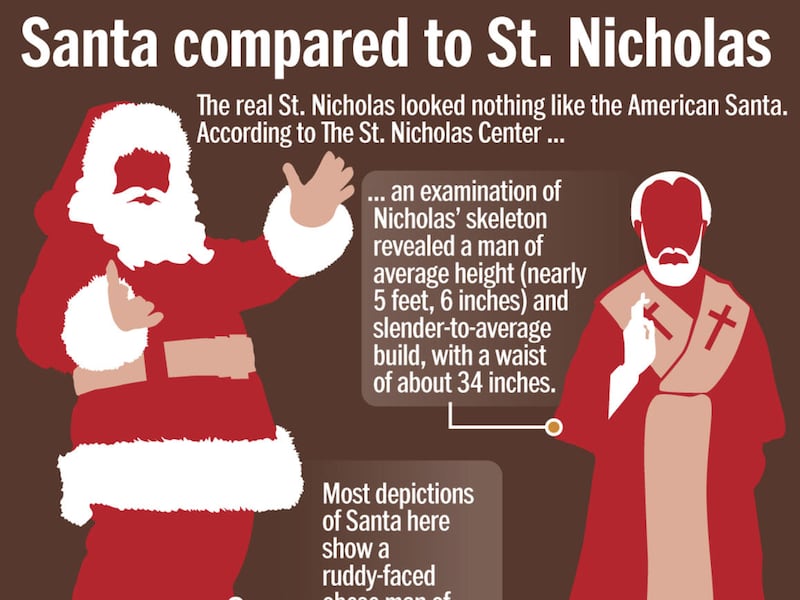He’s overweight and sedentary, has a belly that jiggles and spends way too much time sitting with children on his lap. But Santa Claus wasn’t always obese; America made him that way. And with three-quarters of Americans obese or overweight, some people say it's time for Santa to cut back on the cookies.
“The research right now is very clear that when you’re obese, you’re at a higher risk for heart disease, diabetes and even cancer. And these have been linked to consumption of refined sugars,” said Dee McCaffrey, a formerly overweight chemist, now author of “The Science of Skinny” and founder of Processed-Free America. “And this is something we should warn Santa about: even if he loses weight, if he keeps eating a lot of sugar, he will still be at risk.”
Although few people have ever seen the real Santa, most American children can tell you what he looks like: “chubby and plump” with “a round little belly” that shakes when he laughs “like a bowl full of jelly.” That’s Santa as described by Clement C. Moore, author of the classic poem “A Visit from St. Nicholas,” also known as “The Night Before Christmas.” Moore’s poem, first published in 1822, helped to shape Santa, as did the iconic cartoons of Thomas Nast published between 1866 and 1886 in the periodical Harper’s Weekly.
And the Coca-Cola Co. gets some credit (or blame), too: It has used portraits of Santa in its advertising since the 1920s. Its most famous images were drawn by a Michigan illustrator who used Moore’s poem as inspiration between 1931 and 1964, according to a video on Coca-Colacompany.com.
Haddon Sundblom’s Santa packed on the pounds, and he ballooned from pleasingly plump to dangerously obese. In the Coke ads, he looks to be topping 300 pounds. Moreover, his cheeks are alarmingly ruddy, making him look as though he’s suffering from rosacea or imbibed too much of holiday spirits. Jovial though he may be, this Santa doesn’t look like he has the stamina to walk around the block, let alone travel the world in one night, and it would take not just magic but a miracle to stuff that girth through a chimney.
Santa’s poor level of fitness is even more troubling, given that his physical decline happened so quickly. Prior to the 19th century, he was quite fit, as he still is in other countries even today. At a display of global Santa figures called “Spirits of Giving” at PPC Place in Pittsburgh, only the American Santa is obese; other bearers of gifts have weights nicely proportional with height, and some can even be called athletic. In many countries, Santa doesn’t make reindeer haul him around, but rides a horse or walks from house to house.
These depictions are more in keeping with the real St. Nicholas, the fourth-century bishop who was the inspiration for the modern Santa Claus and whose remains were analyzed in 1957. According to Carol Myers, of Holland, Michigan, who created The St. Nicholas Center (stnicholascenter.com) in 2002, an examination of Nicholas’ skeleton revealed a man of average height (nearly 5 feet, 6 inches) and slender-to-average build, with a waist of about 34 inches. His teeth indicated a diet that was mostly vegetarian, she said. A Greek who ate in the Mediterranean style that has become a dietary craze, Nicholas would have spent a lot of time walking, and “I’m sure he was reasonably fit,” she said.
“Surely Santa has gotten fat from eating so many cookies,” Myers added, noting that the cookies-and-milk offering is a uniquely American tradition, and that in other countries, children leave hay or carrots for St. Nicholas’ accompanying animals.
Three years ago, a Canadian woman who crusades against tobacco use published an updated version of “The Night Before Christmas,” omitting the “stump of a pipe” clenched in Santa’s teeth and the smoke encircling his head “like a wreath.” Pamela McColl loves the poem, although she says the modern Santa is not what Clement C. Moore envisioned, which was "an elf the size of Tinkerbell" not the "full-on man, father figure" he's become thanks (or no thanks) to illustrators.
But on her book's website, McColl declined to fuss at Santa about his weight, saying he seemed to get plenty of exercise “climbing in and out of those chimneys” and adding, “As an aside, I do not think that everyone has to be thin to be fit and a case could be made for greater diversity of body types over the idealized or standard ideal figures portrayed in so much of what we see."
In this, she sides with Mrs. Claus, who, in the classic animated TV show “Rudolph the Red-Nosed Reindeer," urges her husband to eat, saying “You’re going to disappoint the children. They expect a fat Santa,” she said.
McCaffrey, however, sees nothing wrong with gentle nudging to urge Santa to adopt a healthier lifestyle. An excellent snack for him would be flourless cookies or those made with whole grains, or perhaps a cacao-peppermint green smoothie or chocolate espresso cookies to give him energy for his grueling sleigh ride.
If the children insist on leaving out the sugar cookies they made, however, don’t despair.
“If you eat cookies one night a year, you’re not going to get obese,” McCaffrey said. With jolly old elves as with humans, what matters most is what you eat the rest of the year.
Jennifer Graham covers health and wellness for The Deseret News. On Twitter, she's @grahamtoday.


